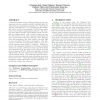Free Online Productivity Tools
i2Speak
i2Symbol
i2OCR
iTex2Img
iWeb2Print
iWeb2Shot
i2Type
iPdf2Split
iPdf2Merge
i2Bopomofo
i2Arabic
i2Style
i2Image
i2PDF
iLatex2Rtf
Sci2ools
SIGSOFT
2008
ACM
2008
ACM
Latent social structure in open source projects
Commercial software project managers design project organizational structure carefully, mindful of available skills, division of labour, geographical boundaries, etc. These organizational "cathedrals" are to be contrasted with the "bazaarlike" nature of Open Source Software (OSS) Projects, which have no pre-designed organizational structure. Any structure that exists is dynamic, self-organizing, latent, and usually not explicitly stated. Still, in large, complex, successful, OSS projects, we do expect that subcommunities will form spontaneously within the developer teams. Studying these subcommunities, and their behavior can shed light on how successful OSS projects self-organize. This phenomenon could well hold important lessons for how commercial software teams might be organized. Building on known well-established techniques for detecting community structure in complex networks, we extract and study latent subcommunities from the email social network of several ...
Open Source Software | Pre-designed Organizational Structure | SIGSOFT 2008 | Software Engineering | Successful Oss Projects |
| Added | 20 Nov 2009 |
| Updated | 20 Nov 2009 |
| Type | Conference |
| Year | 2008 |
| Where | SIGSOFT |
| Authors | Christian Bird, David S. Pattison, Raissa M. D'Souza, Vladimir Filkov, Premkumar T. Devanbu |
Comments (0)

